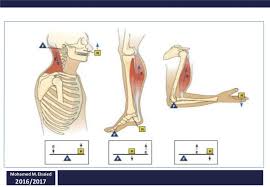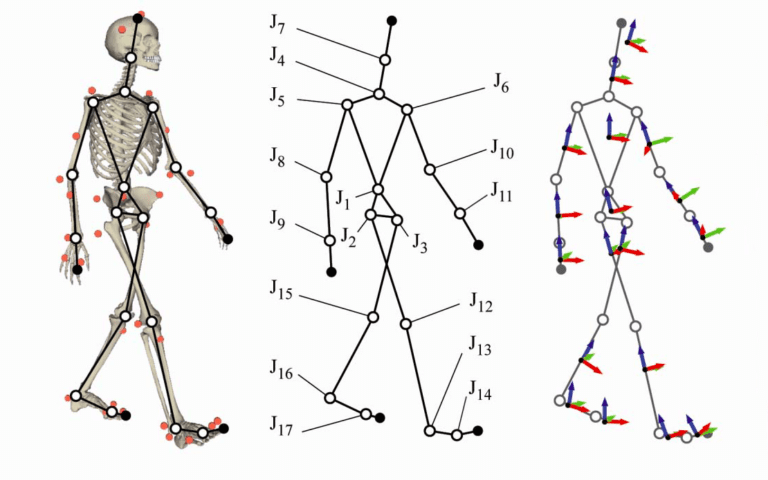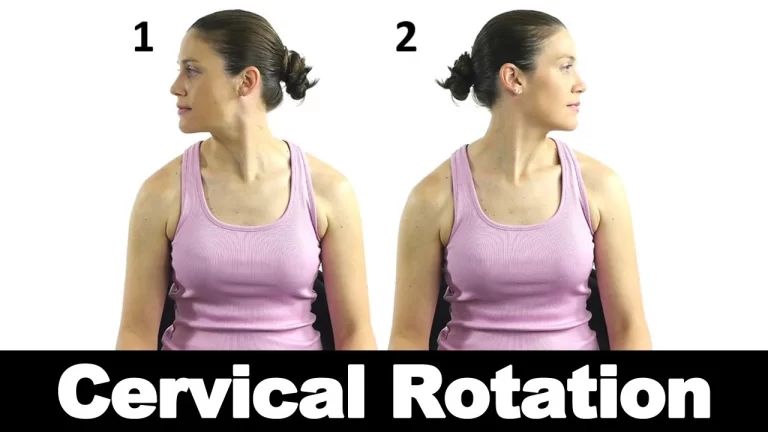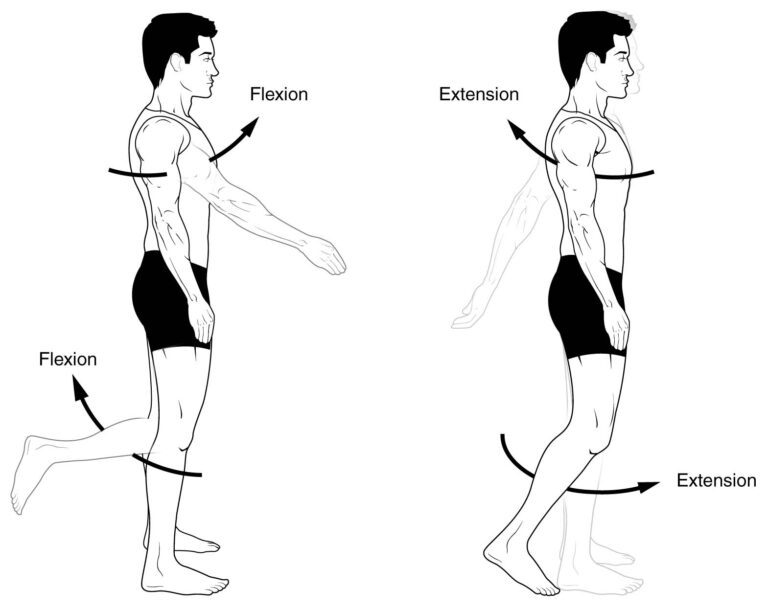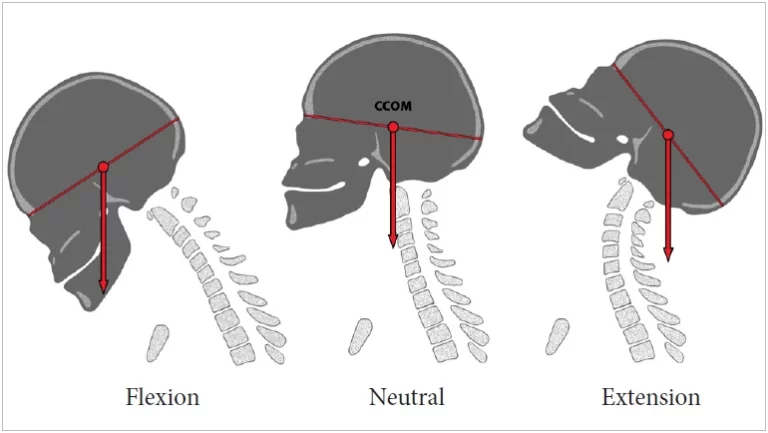PROPERTIES OF ELASTICITY AND USE IN PHYSIOTHERAPY
Table of Contents
DEFINITION :
In physics, elasticity is the ability of a body to resist a distorting influence and to return to its original size and shape when that influence or force is removed.
Solid objects will deform when adequate forces are applied to them.
- If the material is elastic, the object will return to its initial shape and size when these forces are
removed. Hooke’s law states that the force should be proportional to the extension. The physical reasons for
elastic behavior can be quite different for different materials. In metals, the atomic lattice changes size
and shape when forces are applied (energy is added to the system). When forces are removed, the lattice goes
back to the original lower energy state. For rubbers and other polymers, elasticity is caused by the
stretching of polymer chains when forces are applied.
Mechanical Properties: Non-Linear Elasticity
- The structure and composition of tendons allow for their unique mechanical behavior, reflected by a
stress-strain curve consisting of three distinct regions
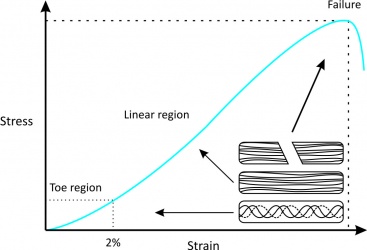
- Toe region: this is where “stretching out” or “un-crimping” of crimped tendon fibrils occurs from mechanically
loading the tendon up to 2% strain. This region is responsible for nonlinear stress/strain curve, because the
slope of the toe region is not linear. - Linear region: this is the physiological upper limit of tendon strain whereby the collagen fibrils orient
themselves in the direction of tensile mechanical load and begin to stretch. The tendon deforms in a linear
fashion due to the inter-molecular sliding of collagen triple helices. If strain is less than 4%, the tendon
will return to its original length when unloaded, therefore this portion is elastic and reversible and the - slope of the curve represents the Young’s modulus.
Yield and failure region: this is where the tendon stretches beyond its physiological limit and intramolecular
cross-links between collagen fibres fail. If micro-failure continues to accumulate, stiffness is reduced and
the tendon begins to fail, resulting in irreversible plastic deformation. If the tendon stretches beyond
8-10% of its original length, macroscopic failure soon follows
Mechanical Properties: Viscoelasticity
- Tendons also have viscoelastic properties (likely the result of collagenous proteins, water, and the
interactions between collagens and proteoglycans), meaning their mechanical behaviour is dependent on the rate
of mechanical strain. In other words, the relationship between stress and strain for a tendon is not
constant but depends on the time of displacement or load. A viscoeleastic material is more deformable at
low strain rates but less deformable at high strain rates. Therefore, tendons at low strain rates tend to
absorb more mechanical energy but are less effective in carrying mechanical loads. However, tendons become
stiffer and more effective in transmitting large muscular loads to bone at high strain rates.
There are three major characteristics of a viscoelastic material of tendons:
- Creep
Indicates increasing deformation under constant load
This is in contrast with the usual elastic material, which does not elongate, no matter how long the load is
applied.
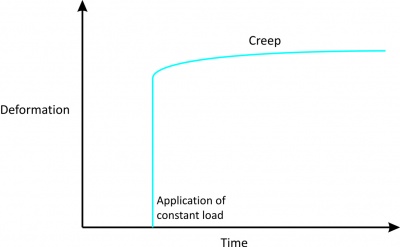
- Stress relaxation
This indicates stress acting upon a tendon will eventually reduce under constant deformation.
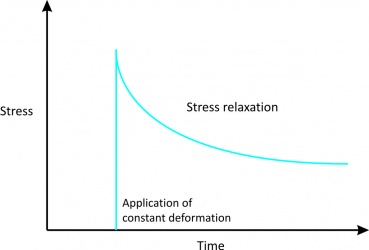
1 Hysteresis or energy dissipation
- When a viscoelastic material is loaded and unloaded, the unloading curve is different from the loading
curve.
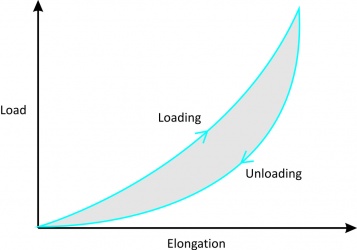
- The difference between the two curves represents the amount of energy that is lost during loading.
- If loading and unloading are repeated several times, different curves can be obtained.
- After about 10 cycles, however, the loading and unloading curves no longer change
(although they are still different) and the amount of hysteresis is reduced allowing the stress-strain curve
to become reproducible
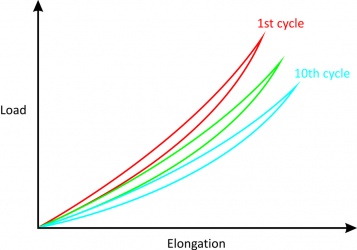
Factors Affecting Mechanical Forces
- Many factors affect the mechanical forces on tendons during normal CREEPlocomotion.
- First, different tendons in the body are subjected to different levels of mechanical loads. For example,
it has been estimated that the peak force transmitted through the Achilles tendon in humans during running is
9 kN, which is equivalent to 12.5 times body weight. In human hand flexor tendons, it has been shown that
the intratendinous force of the tendon depends on whether the force is generated passively or actively, and
whether the position of the joint is in flexion or extension. During passive mobilization of the wrist, the
flexor tendon force was found to be between 1-6 N and up to 9 N during similar mobilization of the fingers.
During a 35 N fingertip pinch, tendon forces can be measured up to 12 N whereas during active, unresisted finger motion, tendon force can reach approximately 35 N.[8] - Second, both the level of muscle contraction and the tendon’s relative size influence mechanical forces on
a tendon. In general, the greater the cross-sectional area of a muscle, the higher force it can produce and
the larger stress its tendon undergoes (e.g. patellar tendon vs. hamstring). - Third, different activities induce different levels of forces, even on the same tendon (in animal models).
Similarly, varying the rate and frequency of mechanical loading results in different tendon forces.
- The Differential Effects of Mechanical Loading on Tendons
Mechanical Load Level Effects on Tendon
- Low
• Tensile strength
• Size
• Collagen production
• Anabolic activities
• Catabolic activities
2) Moderate
• Tensile strength
• Collagen synthesis
• Collagen degradation
• Adhesions
• Inflammatory mediator (e.g. prostaglandin E2)
• Tendon stem cells (TSCs) differentiating into tenocytes
3)Excessive
• Tensile strength
• Collagen organization
• Myofibroblasts
• Inflammatory mediators
• TSCs differentiating into nontenocytes (adipocytes, osteocytes, chondrocytes)
• Leukotrienes (edema)
TREATMENT
Increased Tissue Elasticity
- Increased tissue elasticity is a common benefit gained through massage. Tissue elasticity is the ability of
elastic fibers to allow muscles to stretch to their full range of movement. A variety of techniques are used
to help increase tissue elasticity within a massage. Increased tissue elasticity can decrease tightness and
tension and can increase the range of movement. Our massage therapists at Physio.co.uk aim to increase tissue
elasticity through massage to help decrease pain, improve relaxation and prepare a person for activity.
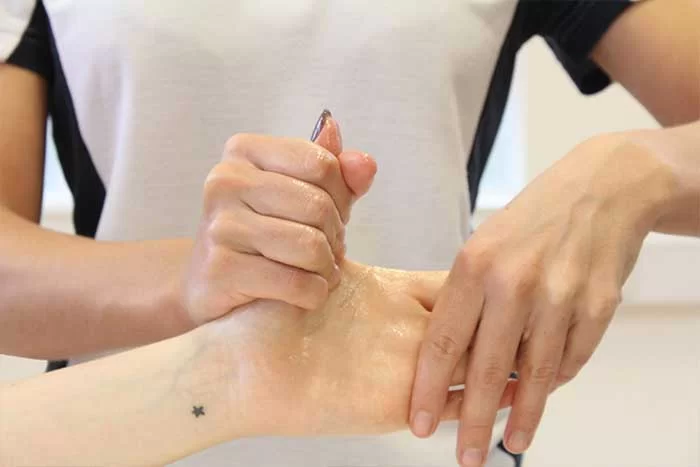
Increased Tissue Elasticity
Increased tissue elasticity is a common benefit gained through massage. Tissue elasticity is the ability of elastic fibres to allow muscles to stretch to their full range of movement. A variety of techniques are used to help increase tissue elasticity within a massage. Increased tissue elasticity can decrease tightness and tension and can increase the range of movement. Our massage therapists at Physio.co.uk aim to increase tissue elasticity through massage to help decrease pain, improve relaxation and prepare a person for activity.
What is increased tissue elasticity?
Tissue elasticity is the ability to stretch a muscle to reach its full range of movement without restriction.
Different types of tissues can be found within the body including soft tissues and connective tissues. Tissues often become restrictive and inelastic resulting in an increase in muscle tightness and pain.
When tissue elasticity increases, muscle flexibility and range of movement is increased and muscle tightness, tension, and pain is decreased. A massage encourages an increase in blood flow around the treatment area to help increase muscle temperature. An increase in muscle temperature helps to increase tissue elasticity. Elastin fibres are what allow tissues to increase in elasticity.
What are the benefits of increased tissue elasticity?
There are many different benefits of increased tissue elasticity. Benefits of increased tissue elasticity
include:
- Increased range of movement
2) Decreased pain
3) Reduced tightness
- Increasing tissue elasticity can increase the range of movement. In-elasticity of tissues can result in an
increase in restriction. Restriction can decrease the range of movement. Decreased range of movement can also
increase the risk of injury during activity. During a massage, the temperature of muscles increases due to an
improvement in blood flow. Increasing muscle temperature decreases tissue in-elasticity and increases
the flexibility of the muscles. Increasing tissue elasticity and flexibility results in an increase in the range of
movement as the restriction is reduced. - A common benefit of increased tissue elasticity is decreased pain. When tissue elasticity is decreased,
the increase in restriction can result in pain. Restriction prevents muscles from reaching their full range
of movement causing an increase in tightness and tension. Increasing tightness and tension further increases
pain. An increase in blood flow occurs during a massage, increasing muscle temperature. An increase in muscle
temperature helps to increase tissue elasticity and reduce restriction. Reducing restriction can decrease
tightness and tension. Decreasing restriction, tightness, and tension by increasing tissue elasticity all help
to reduce pain. - Reduced tightness is a benefit gained through increased tissue elasticity. Decreased tissue elasticity can
increase muscle tightness due to an increase in restriction. An increase in muscle tightness can also increase
pain. A massage encourages an improvement in blood circulation which helps to increase muscle temperature.
When muscle temperature rises, tissue elasticity increases. Increasing tissue elasticity allows muscles to
relax and increase in range of movement. Relaxation of muscles results in decreased tightness and pain. - What techniques are used to increase tissue elasticity?
A variety of techniques can be used to increase tissue elasticity. Common techniques used to increase
tissue elasticity includes:
- Kneading
2) Skin rolling
3) WringinG
- In what situation would increased tissue elasticity help?
Increased tissue elasticity can help in many situations. Situations that increased tissue elasticity can help
include:
- Acute Pain
2) Pre-event
3) Relaxation
- Acute pain can be helped when tissue elasticity is increased. Pain can be a result of many things.
The most common reasons for increased pain include muscle tightness and tension. Muscle tightness and tension is
often caused by the inelasticity of muscle tissues which create restriction. During a massage, tissue elasticity
is increased as muscle temperature rises. A rise in muscle temperature occurs as blood flow is increased.
Increasing tissue elasticity helps to relieve restriction and decrease muscle tightness and tension.
Decreasing muscle tightness and tension, therefore, results in a reduction in pain. - Increased tissue elasticity can help pre-event. Before a person participates in an event muscles tend to be
tight and restrictive, decreasing the range of movement. Muscles are often this way due to the intensity of
training. Decreasing the range of movement can increase the chances of injury during short bursts of movement.
Injuries more likely to occur include muscle pulls, tears, and strains. Increasing tissue elasticity helps to
relax muscles and decrease tightness and tension. Decreasing tightness and tension and improving tissue
elasticity also help to reduce restriction and increase the range of movement. Increasing the range of movement helps to prepare a person pre-event and reduce the chances of injury. - Increased tissue elasticity can help improve relaxation. A person can become physically unrelaxed when muscles remain tense and restricted in movement. Tense muscles and restricted movement can both increase pain and further reduce relaxation. During a massage, an increase in circulation occurs causing a rise in muscle temperature. An increase in muscle temperature helps to increase tissue elasticity. Increasing tissue elasticity reduces restriction and allows muscles to relax. Allowing muscles to relax decreases tension and increases the range of movement. Decreasing tension and increasing the range of movement can decrease pain. Decreasing restriction and decreasing pain improves relaxation.


